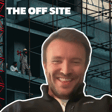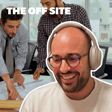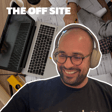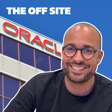Become a Creator today!Start creating today - Share your story with the world!
Start for free
00:00:00
00:00:01

The Sydney Metro Opens, DocumentCrunch raises $9M, and Honolulu’s $1.6Bn rail
Jason and Carlos have another 3 topics to run through this week on the podcast!
The duo celebrate the opening of the newest section of the Sydney Metro network, and then talk about the most promising new AI tool they've seen called DocumentCrunch, before finally touching on Hawaii's $1.6 Billion plans for a new Metro in Honolulu.
Transcript
High Costs of Honolulu Rail Project
00:00:00
Speaker
1.6 billion pounds for three miles of rail with six stations is nuts. Now, I have no idea. I think that's island tax, right? I think that's an island. Yeah, I was going to say I have no idea the cost of shipping construction materials, which we assume are not produced on the island to the island. So that's going to have a horrible effect.
00:00:20
Speaker
you probably have to relocate a lot of the workforce too. So there's going to be loads of costs that we just wouldn't be able to understand what that looks like. But if you look at London's DLI, it was like one and a half billion. It's pretty expensive. It's like 30, 40 kilometres, 45 stations. It was built in the 80s, but if you apply inflation. Yeah, so have you done inflation? I did apply inflation and it takes up to 1.5 billion. I think there's some costs missing there because that's great value. Almost unbelievable.
Introduction to Off-Site Podcast
00:00:56
Speaker
Welcome back to the off-site podcast. Carlos, good to be with you, mate. What's been going on? It's a pretty cool project in the news at the moment. And hello to you. didn i had i Sorry, I thought we were in the zone today. Now, you see, as the owner, they've won a contract to build a hip-hop museum in the Bronx. So I think coolest project ever award has to go to them. What's the size of this hip-hop museum?
00:01:23
Speaker
Yeah, hip-hop museum in the Bronx, obviously New York, won by a sea owner. I can't remember, I think it was like 15,000 square feet, ah which I don't know how many football pitches that is, but I've got a football pitch reference later to for you, so I won't ruin it now.
00:01:38
Speaker
put that on the holiday list. I think they put that on the holiday list. Sorry, I just started Googling hip hop museums. ah Yeah, that's cool. Yeah.
Logistical Challenges of Honolulu Rail
00:01:47
Speaker
And then the other one was um Disney have committed to extending their Florida and California theme parks. The Florida one alone is 17 billion, 15,000 acre expansion. So yeah. so and the older That definitely brings back memories of RollerCoaster Tycoon and thinking about how you'd lay those.
00:02:09
Speaker
Get the old grab and drop people into the lake. Yeah. And the trick is to like, you cut off the roads so people couldn't leave. And then you just put a million umbrella stores and then wait for it to rain and put the price up to the maximum. And that is the cash. And yeah, you learn a lot of business lessons out of, ah out of rollercoaster tycoon. That is capitalism.
00:02:34
Speaker
Yeah. Don't let them leave, get them in, make it rain. And then you have the ghosts floating about, don't you? When everyone dies, because you don't like people, people die. that yeah i I didn't, I never, without the free veners I thought I, I thought I was bad getting him in there without, that without, without a way to get out, but I always gave them food and toilets. I'll talk to my therapist about it.
00:02:58
Speaker
that There's a side note. there's some ah There was an interesting conversation the other week a few with with a few of the team members talking about what they used to do in The Sims. There's some really sadistic shit that goes on in The Sims, but I won't name names. I think my wife was one of those sadistic people, but we're not going to get into that. I gave you an opportunity then to just like move on topic and then you just named dropped your wife. so um
Sydney Metro's First Section Opens
00:03:22
Speaker
Cool. We've got some interesting, with three interesting topics to chat through today as a sort of jumping off point. So first of all, we've got the opening of the first a section of Sydney Metro in Australia, um which has been all over the news here, which we can dive into.
00:03:39
Speaker
Then we have been talking a bunch internally about, again, yeah yeah uses of AI, but this one's super exciting. The company DocumentKunch, a US company, raised money earlier this year. Looking at what they can do has got us pretty excited.
00:03:55
Speaker
And then final one is the, I think probably the the project that everyone wants to go on, um is going to be the new section of the Honolulu Rail Transit Project that's been awarded, the $1.6 billion dollars project that's just been awarded in the US. So we might be seeing some transfers requests going in. Yeah, that would be a pretty nice one. You'd work all day in Southwell evening, I'd imagine.
00:04:19
Speaker
or the other other way around. Yeah, sign up for the night shift. So off the bat, Sydney Metro. So at about 5am this Monday, just go on as we were recording, the first section of the new Sydney Metro network was open to the public, a 15.5 kilometer section from Chatswood to Sydenham.
00:04:41
Speaker
was expected or is expected to handle around 34,000 passages an hour during peak travel times. And it's the first of two sections in the second stage of the the massive $64 billion mega project. This is Australia's biggest ever infrastructure investment. in watching ah You might not have seen it as much over there. I don't know if you you have, Carlos, but in watching the news I was getting a lot of vibes of the opening of Crossrail where people were really excited to start to finally be able to get on their recording videos going through there. And for people that worked on it, the ability to finally see ah something that you contributed to being used and enjoyed, I think in the first day 190,000 people wrote on this section.
00:05:30
Speaker
ah well um So yeah, it reminded me a lot of the opening of of Crossrail and and seeing people really yeah enjoying a piece of infrastructure that was delivered. Yeah, when you spend that many years working on, obviously it looks like a single project. When you're in the job, it feels like a series of projects that are working over a period of time, but it all sort of builds up to that moment. So yeah, it must have been awesome for anyone that's working on it. For people like me that doesn't really know Sydney, so is this a north to south line, a bit like London's northern line, I guess, going down towards the airport?
00:06:03
Speaker
it's It's like much more significant. So it is the overall scheme of Sydney Metro actually involves four separate lines. So there's a Metro North West line, which is yes ah which a large section of which was opened 2019. So even though this was touted as the opening, there was actually a section that was opened a number of years ago. But this section is the first bit that kind of goes across the city.
00:06:28
Speaker
yeah which has been the most significant part of the investment. ah Then there is a ah metro city and southwest line, which is what this is part of. yeahp Then there is a metro west line, which goes out towards the western suburbs, and then a metro western Sydney airport line, which is ah ah out in the far western suburbs that connects to the new airport. yeah The northwest line is now I think almost totally open as part of this. Then the city and southwest is partially open as part of this opening. There is another section of city and southwest to be still worked on and opened I think next year.
Value for Money in Sydney Metro
00:07:07
Speaker
And then Metro West and the Western Sydney Airport sections are currently under construction um with big tunneling packages underway for for the Western, and ah for Metro West. And then the tunneling, ah that ah the stations packages underway for the Western Sydney Airport. So the overall scheme is 46 stations across four lines and 113 kilometres of new track.
00:07:31
Speaker
Yeah, it's pretty impressive value for money. And I'm about to tie value for money back to a British project, which isn't always the strongest to play. But um yeah, very similar because Crossrail was what, 42 stations? This this is 46, very similar, over 100 kilometres of track, again, very similar, and about two thirds of the cost. So, um yeah. Crossrail, we've got a final bill all there or thereabouts.
00:07:58
Speaker
Yeah, sure. You have got another section. Are they the final section is due next year? ah No, I think the the final section of the city and southwest line is due next year. But the overall Sydney Metro, I think they're planning to award later this year the stations packages for the Metro West and those stations will be a number of years themselves. So I think there's still a few years to go.
00:08:21
Speaker
Yeah, okay. But the 21.6 billion, that is the current forecast, the total cost of... like yeah it's Yeah, reported somewhere at some point. I'm sure someone listening to this will have a ah probably more accurate ah view of what that is really.
00:08:38
Speaker
You know when we were working on Crossrail, I recall very clearly sitting in meetings looking at forecast final costs of projects that were multiples of what was being publicly reported at the time. So I'm sure someone has... more accurate information than we've gotten from the news. No comment on the old Crossrail forecasts. I think it's past statute of limitations, maybe. Yeah, not a lot. Yeah, yeah, easy to stay quiet about. And this
Reducing Road Congestion with Sydney Metro
00:09:10
Speaker
is to reduce congestion on roads, presumably, because there's not sort of a massive tube lines and and rail systems throughout the city centre.
00:09:18
Speaker
Yeah, it's one of the hardest places to commute in Australia is from the western suburbs and and certain suburbs of Sydney into the city. And so you're definitely getting people off roads on top of big road projects that in recent years, they opened ah the West connects, which is a big road tunnel project as well. So there's a huge amount of investment. It was the congestion in Sydney is and and was horrific ah for people to be able to get to work.
00:09:45
Speaker
Yeah. Okay. And obviously it's pulling people in from the two airports as well. So that'd be the quickest way to get into the city you'd imagine. We'll have to correct this if I'm wrong, but I can't, ah yeah, there is a rail line from the airport, ah from the current airport, definitely from the new airport. Yes. I can't recall. I've never gotten the airport, the train from the current airport.
00:10:04
Speaker
I was going to say that's because Australia has the best Uber system in the world where it actually manages, or is that just Melbourne? No, do you mean the like car airport? It gives you a number and then you walk up to the first car and you're not like, where's this guy running around the car park? Yeah, yeah. But certainly the getting to see people enjoying the piece of infrastructure, getting to observe that as someone that worked on it was that just immediately brought me back to the opening of Crossrail.
00:10:33
Speaker
which was a tremendous feeling. And then the excitement of getting to actually ride on it ah the first time. And I did the like classic thing that everyone probably did, which is take family members onto this ah train and be like, this this was a problem in this part of the project. And then here we did this. And they're like, cool story. night And then they're like after after like half an hour of a walkthrough of the project, they're like, oh, this train has air conditioning. That's nice.
00:10:58
Speaker
so yeah I the same thing. The trainer's Wi-Fi. Cool. yeah On Paddington, they're these huge, they must be like five by five meter pre-cast panels on the ceiling. Yeah. And they're these like curved domes, which has a light.
00:11:15
Speaker
So I was like ah this like, there was huge issues with actually getting those into place and and actually casting them. And I remember saying that, and the response I got was, that's a lamp shade. I was like, OK, cool. Yeah, there's Wi-Fi on the train. Let's go.
00:11:30
Speaker
It's really hard to get people caring about all the problems that you sweated over for like five years. Yeah, I think that the it's the ultimate satisfaction in construction. Getting to observe people nonchalantly using something that you've enslaved over for many years as though it yeah is like just part of their everyday life.
00:11:51
Speaker
Yeah, my favorite thing is when I go back, I went through the station the other day with an engineer who I worked with on that project. And what I have to say is we built that and it triggers the engineers so hard to be like, what do you mean you built that? You didn't build anything. Job done.
Document Crunch: Innovating Construction Contracts
00:12:07
Speaker
the Jumping on to the next topic, earlier this year, a US startup called Document Country Company ah in the in the construction technology space raised about nine million US million in funding for a product that takes ah kind of amalgamates construction, AI and contract and and kind of legal ah review.
00:12:30
Speaker
It was something that I had observed and watched and I recently listened to another podcast where they were talking about it in more detail. I probably should shout out the Bricks and Bites podcast. It just got me thinking massively about if I was a construction engineer on a project today, how much I would be totally enamored with this product. And so we can definitely dive into that. And then on the flip side, um thinking about it from the perspective of you know as a startup, the idea of how sustainable, how defensible is the product that they're they're building. So um I guess on the first side, what the product does is allows teams to upload or connect legal documents from construction, so scopes over contracts, and it will help crunch those documents
00:13:18
Speaker
like risks and opportunities, understanding positions. I had read that the plan is to be able to connect it in certain ways to the field through integrations with things like Procore. So it can help identify in the field from, I don't know, maybe if you imagine a workflow someone completes a site diary, which has a record in it that then might trigger a right or an obligation or an action that needs to be taken to be able to help them spot that and take that action.
00:13:45
Speaker
The list of opportunities there is somewhat endless and all I could think about was a project that I'd worked on many years ago where we, I guess one of the things that happens in construction is that clients have a lot of power in the process of contracting usually depending on the the state of the market and they kind of push quite onerous conditions on the contractor who really wants to to win the the project. And so the contract is left with these fairly onerous head contract, prime contract terms. And then they, in turn, generally, they're not fully across every term, condition, detail of all those contracts. And rather than pick out all the salient points that they need to subcontract or subcontractor, they just do the classic QS move of back to backing the um
00:14:32
Speaker
the contract where they push all the terms that they've agreed to onto their subcontractor in addition to the terms that they want to push to the subcontractor. And you get this like cascading of paperwork down the supply chain. And I remember being a subcontractor with a hunt a multi-hundred million dollar subcontract package to on a project many years ago where our our head contract was over 3,000 pages long. For three months as a management team, I remember the conversation about trying to understand what our rights and obligations were under that contract and the thought of how we would even get to a spot where we could understand the rights and obligations of under the contract.
00:15:11
Speaker
And it ended up never happening. And so we would constantly find these situations where the managing contractor would say, page 2642 says, you're supposed to you're supposed to do whatever we want. Here, here, here. There was probably 14 spots that that was contradicted. But finding those spots was was ah like needle in a haystack.
00:15:32
Speaker
The ability and the way that this could level the playing field for the smaller contractors, the ones where the the kind of ship gets pushed downhill towards them, I think is game changing. If I was in construction on a project right now, especially if I was on the receiving end of one of these contracts, I'd be all over this. Yeah, 100%. I still remember my first day um on a project and someone just said, here's the works information, read that. And it was like,
00:16:01
Speaker
masses of paperwork, right? yeah um Looking into this tool from the point of view of the quantity severe, it's nice to see finally a tool that actually you could imagine boosting productivity. When I left construction, the productivity boost was e-signatures, which isn't a productivity boost, it's doing something faster. It's not like you're sat there waiting for it to come back and not doing anything else. So like, you're not doing any more, something just takes a bit longer.
00:16:24
Speaker
Sorry, the fact that you said when you left construction was easy. That's like when someone says that. When I left construction, the big productivity boost was mainframe computers. where It was CAD. yeah yeah I used P3 back in the day. By the way, it wasn't that long
Boosting Productivity with Contract Analysis
00:16:41
Speaker
ago. It's just, they were so far behind in using e-signatures to every other industry. If we go back to, if you're working on a subcontract package, you spend so much time reading through documentation, whether it's pre-contract signing. So you're actually negotiating a contract or trying to pull together a contract with the subcontractor to sign or managing that sub-contractor through the life of the project. Yeah. There's what you've already mentioned, which is identify like, risk provisions and understanding some of the complexity where you've got lots of terms across a document that may counteract each other and you're trying to form a view on where your position is because
00:17:16
Speaker
as a QS and a main contractor, you want to get as back to back as possible with the supply chain below. And the supply chain want to have a safer contract as possible and push back as much as they can. There are many terms which would be unreasonable and unfair to push onto a subcontractor if those terms could cripple them over what could be like a mild mistake. So that stuff would be amazing. The ability to review and provide back that feedback in a tool that all of us have used things like chatgbt to generate sort of summaries and to highlight aspects of um a document.
00:17:49
Speaker
But then they go quite deep. So there's one part of the tool, which it will basically review contracts or documentation against company standards. And then point out where like, this isn't suitable because of X. So that's really cool. They've got another one, which is a playbook feature. So when someone joins a job, um, it runs training on like the contracts obligations and key provisions. So like, hundred hundred percent like, games that's amazing.
00:18:16
Speaker
hundred percent And that's the sort of stuff that when you like pull together a subcontract, you give it to the commercial manager, they click to page seven and they go, that's fucking stupid. And they give it back to you yeah to just know like what you're aiming for for a junior member, even a senior member, and to have a playbook on like this is the key stuff for this project that like is minimum standard. This is the bar.
00:18:37
Speaker
if if if you If you went and looked at any lessons learnt report for any major project, I'm sure in there somewhere is a lesson learnt about teaching new starters the contract rights and obligations because as projects go on, there's always scope creep, they're always missing opportunities. this The ability to yeah bring people up to speed instead of just giving them the 3,000 pages which certain types of personas will go and read and internalize but that's the minority game changer. Yeah it's huge and then there was ah there was another part where at project completion you can feedback information against the contract so it identifies which areas of the contract were actually weak because of cost overruns so you can then consider that for future contracts so like
00:19:23
Speaker
It's not just saying, do this, do this. It's actually taking that information back and going, cool, this didn't work. So next time you need to do X. yeah So it's actually pointing out the vulnerabilities. The reason I'm so excited is like we we know this works even at a really basic level. like It's no secret, like internally within our company, we've been reviewing contracts and ah insurance documents and all sorts, just using the standard models, through whether it's like ah usually Claude is the the best. This is not a paid ad for Claude.
00:19:53
Speaker
We've negotiated whole contracts using that. And then, uh, when we need to kick in things to a real, real life lawyer, the impact that that has on being able to understand what is market standard, where two clauses contradict each other. That's like in every construction contract. The biggest thing is people go to write these things. And I don't know, depending on the size of the contract, the team writing them is massive. They're not one person. No, one is more like no one Yeah, and there's always contradictions littered through the entire thing. And half of the arguments that I've ever had on projects in trying to sort out the requirements of the project have been in openly contradictory terms throughout the contract. yeah And so it definitely, something in this area definitely works. You can use it right now by just ah using the the out of the box models.
00:20:41
Speaker
yeah I guess that leads to the the opposite ah side of it. you know as There's often this knock on AI startups that there people always say that they're like a thin wrapper of an underlying model. you know You're a bit of a UI on top of an open AI or an anthropic model. And I don't know that I totally agree, but that's ah it's a that's ah common knock on on most AI startups or many AI startups.
00:21:08
Speaker
And ultimately, they'll be doing something clever around how they're doing the retrieval, the storage, what what techniques they're using, where for it to work well. But there is this paradigm that happens when you're trying to solve a problem like this or, you know, we've seen as well. You spend so much time getting the right, let's say, product market fit. What's the combination of interactions, behaviors, features that you need to have?
00:21:33
Speaker
And the question is if they do invest that time money and solve it and because I think it will be great, how easy is it for their own customers or a competitor to basically observe what the certain behaviors are and just use the the models to to make their own version of it without paying them?
00:21:53
Speaker
So that's going to be the interesting test around how tightly it can be integrated at the right, at all the different levels that it can have an impact. Cause if it's just, we can review your document, Claude will do that pretty well now for like 20 bucks a month or whatever.
00:22:10
Speaker
Yeah, if anyone could just whitelist or white label one of the standard tools, do a little bit of work, and then suddenly it spits out the right sort of answer in a bit of UI that makes sense to the audience, then yeah, you're in a difficult spot. ah And people will look at it because like,
00:22:25
Speaker
They claim that you can reduce contract review by 80%. I never normally believe these big percentagees ah bad percentages, but I believe that you probably be you could probably better that. yeah So when do you start throwing in like market size numbers of construction, like people will take notice if if they get even a ah little bit of success. So you'd expect a whole herd of followers pretty quickly.
00:22:48
Speaker
Cause the, yeah, like the, the review of a contract and spotting, you know, generating a rights and obligations or finding, um, contradictions, those things, there's probably some techniques of how they feed that and prompt that, uh, and, and manage that data. I don't imagine that's wildly complex.
00:23:12
Speaker
The ability to observe some of the behavior of what's happening on the project and then surface when those things have contractual implications is really interesting. Like you could observe that there was a delay if you were integrated with the right set of tools, observe that there was a delay. So there's this kind of like observing workflows. Based on the contract or whatever that might be. Yeah. And then that kind of propagates or drafts the the earlier warning.
00:23:40
Speaker
We use a tool at the moment ah in our business where we have these kind of workflow set up. Something happens, it triggers it to go to ah an AI model, it writes something, pushes it over here, then goes up there. You can see how like each site diary, for example, should get checked and scanned and then an action off the back of it, for example.
00:23:57
Speaker
So yeah, there's some bits of that which would be hard. It's hard to build without developers and good developers, et cetera. Yeah, it's really interesting. And the idea that it understands hierarchy and relationships, that must be a bit, I don't know if that is complicated or not, because you probably just trained the model.
00:24:15
Speaker
An interesting thing on the other side, I don't know if this applies in this case, but there's been a recently a bunch of news stories that I was looking at this morning where companies are pausing rollouts of ah Microsoft Copilot. This is kind of like a side note, but it's because Copilot and things like Slack's AI tool, you can very easily hack it around permissions. So documents that you're not supposed to have access to, you can get it to return information from those documents. really um channels that you're not supposed to have access to because if you think about it the model itself in order to retrieve the information has to have like broad permissions within the company's data set and then it's trying to apply a level of control at the user level that's interacting with it but if you play with the prompt you can get it to you can get it to go beyond what you should have access to.
00:25:01
Speaker
And so that's causing like a bit of a pause in some companies rolling out Microsoft co-pilot. This here, I think it would be easier because you're probably bounding it to mostly to the project and people that should have access to it. yeah But if it's when they're going to like company playbooks or thinking about broader reviews, I don't think that's going to be as much of a problem in this case, because most people on the project should have access to those documents.
00:25:26
Speaker
Anyway, that is super interesting. i would ah i going to keep There's so many hours, there's so many hours that I could have gotten back in my life if they could have had that 10 years ago. ah God damn it.
Honolulu's Major Transit Project Contract Awards
00:25:40
Speaker
Okay, jumping onto the last topic. This is the topic of everyone in countries like the UK and Europe putting in resignation notices to transfer to Honolulu. In the news, the city of Honolulu has awarded the CCGS project, the city center, guideway and stations contract for the Honolulu rapid transit system ah to Chutaparini, a general contractor. The project is worth, or the contract is worth 1.7, approximately billion USD and is supposed to kick off late this year or early next year.
00:26:18
Speaker
um So it's essentially a light rail project with a number of stations running through the through Honolulu You're all over this you've been booking flights and looking at accommodation. What are you what have you found, mate? I've got a demo in person next week. So that's all right Yeah, really cool projects. Obviously, it's a dream job for anyone who fancies three or four years in Hawaii um you take it the first thing is 1.6 billion pounds for three miles of rail with six stations is nuts. Now, I have no idea. I think that's island tax, right? I think that's an island. Yeah, I was going to say, I have no idea the cost of shipping construction materials, which we assume are not produced on the island.
00:27:03
Speaker
to the island. So that's going to have a horrible effect. You probably have to relocate a lot of the workforce too. So there's going to be loads of costs that we just wouldn't be able to understand what that looks like. But if you look at London's DLI, it was like one and a half billion. It's pretty exp expensive. It's like 30, 40 kilometres, 45 stations. It was built in the 80s, but Yeah, I'm sure if you've done inflation, if you've done inflation, I did apply inflation and it takes up to 1.5 billion. I think there's a cost missing there because that's great value. ah Almost unbelievable. It's pretty much the equivalent, a driverless above ground elevated light rail. So ah maybe the Honolulu tax is higher than the ah the London tax, which is nice to hear.
00:27:46
Speaker
No, I can't. Yeah, that's tremendous value. the The contractor that's been awarded the project, Tudor Frini, I hadn't actually heard a ton of about, but they are, they're a large general contractor. I but i had no idea how big they were. Yeah, 4 billion revenue and 8,000 people.
00:28:07
Speaker
Yeah, and yeah, based out of California had it was like, like every construction contractor, it's like the merger of two Tudor and then Perini from years ago, and had delivered projects like yeah, the California high speed rail that we talked about a few weeks ago, and the the awesome Hudson Yards project in New York. I don't know if you've seen that, but that's Yeah, there's some awesome docos on on that um on that project. So the other thing is, I wonder if we could get a tax um deduction for travel to just in case any accountants are listening. um block here is ah But yeah, could you get a tax deduction for flying to I think say business expense. I'll be there. You go the other way around. You must do.
00:28:52
Speaker
the other way around. you go figure Yeah, we could direct there. It's super close. otherwise it's Otherwise it's like doing a full, it's like, uh, yeah, it'd be like not being able to turn left, like Zoolander. It's like right there.
00:29:04
Speaker
yeah It'd be super weird to do a whole lap of the world just to get back there. Yeah, I just realized where it is is like halfway between you and LA, right? yeah Yeah, it's really close. It'd be terrible be a tearup you would have had a terrible up if you've done a whole round the world trip to get to to Hawaii from Australia. Yeah, um I think we have to mention their website.
00:29:25
Speaker
Do we? um wasn't going any yeah um we've We've seen a lot of poor websites for this one's almost like a classic. Yeah, picture like year like 1999 Amazon website, the kind of that yeah that kind of level. Very grey and even all the little blocks have like the shadow on the right and the bottom like you had in where.
00:29:50
Speaker
Yeah, so a company that's valued at 10 billion pounds has what is now a five pound website, which is impressive. But hey, they're still winning billion pound jobs in Hawaii. So it's about it's about the work you do, not about the how jazzy your website looks. Speaking of which, we're just doing some website work at the moment, actually. So ah yeah, cool. You should ah find out who built theirs and make sure it's not them.
00:30:18
Speaker
I think we're going to run up on time. So do you want to read us out? Yeah, yeah, no. Thank you very much, everyone, for listening to this show. um If you did enjoy today's episode, please do like the video or follow us on your chosen podcast platform. um We really do appreciate your support and we'll see you next week. Thank you.



















